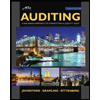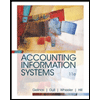
Intermediate Accounting, 10 Ed
10th Edition
ISBN: 9781260310177
Author: Mark W. Nelson, Wayne B. Thomas J. David Spiceland
Publisher: McGraw-Hill Education
expand_more
expand_more
format_list_bulleted
Question
Chapter 6, Problem 6.14DMP
To determine
Revenue recognized point of long term contract
A long-term contract qualifies for revenue recognition over time. The seller can recognize the revenue as per percentage of the completion of the project, which is recognized as revenue minus cost of completion until date.
If a contract does not meet the performance obligation norm, then the seller cannot recognize the revenue till the project is complete.
The revenue recognition principle
The revenue recognition principle refers to the revenue that should be recognized in the time period, when the performance obligation (sales or services) of the company is completed.
To discuss: The arguments made by both students, and explain which argument should be supportable.
Expert Solution & Answer
Want to see the full answer?
Check out a sample textbook solution
Students have asked these similar questions
I need assistance with this general accounting question using appropriate principles.
Can you help me solve this general accounting problem with the correct methodology?
There are different tools for analyzing the financial statements of a company, such as horizontal analysis, vertical analysis, ratios for measuring financial health and profitability, and so forth. Why do we need different tools for analyzing financial statements? Don't the numbers in the financial statements speak for themselves?
Chapter 6 Solutions
Intermediate Accounting, 10 Ed
Ch. 6 - What are the five key steps a company follows to...Ch. 6 - What indicators suggest that a performance...Ch. 6 - What criteria determine whether a company can...Ch. 6 - We recognize service revenue either at one point...Ch. 6 - What characteristics make a good or service a...Ch. 6 - Prob. 6.6QCh. 6 - What must a contract include for the contract to...Ch. 6 - How might the definition of probable affect...Ch. 6 - When a contract includes an option to buy...Ch. 6 - Prob. 6.10Q
Ch. 6 - Prob. 6.11QCh. 6 - Is a customers right to return merchandise a...Ch. 6 - Prob. 6.13QCh. 6 - Under what circumstances should sellers consider...Ch. 6 - When should a seller view a payment to its...Ch. 6 - What are three methods for estimating stand-alone...Ch. 6 - When is revenue recognized with respect to...Ch. 6 - In a franchise arrangement, what are a franchisors...Ch. 6 - When does a company typically recognize revenue...Ch. 6 - Prob. 6.20QCh. 6 - Prob. 6.21QCh. 6 - Prob. 6.22QCh. 6 - Must bad debt expense be reported on its own line...Ch. 6 - Explain the difference between contract assets,...Ch. 6 - Explain how to account for revenue on a long-term...Ch. 6 - Prob. 6.26QCh. 6 - Prob. 6.27QCh. 6 - Timing of revenue recognition LO53 Estate...Ch. 6 - Allocating the transaction price LO54 Sarjit...Ch. 6 - Existence of a contract LO5-5 Tulane Tires wrote...Ch. 6 - Prob. 6.6BECh. 6 - Prob. 6.7BECh. 6 - Performance obligations; warranties LO55 Vroom...Ch. 6 - Prob. 6.9BECh. 6 - Prob. 6.10BECh. 6 - Variable consideration LO56 Leo Consulting enters...Ch. 6 - Prob. 6.16BECh. 6 - Prob. 6.17BECh. 6 - Prob. 6.18BECh. 6 - Prob. 6.19BECh. 6 - Prob. 6.20BECh. 6 - Prob. 6.21BECh. 6 - Estimating stand-alone selling prices: expected...Ch. 6 - Estimating stand-alone selling prices; residual...Ch. 6 - Prob. 6.24BECh. 6 - Prob. 6.25BECh. 6 - Contract assets and contract liabilities LO58...Ch. 6 - Long-term contract; revenue recognition over time;...Ch. 6 - Prob. 6.34BECh. 6 - Long-term contract; revenue recognition upon...Ch. 6 - Long-term contract; revenue recognition; loss on...Ch. 6 - Prob. 6.1ECh. 6 - Allocating transaction price LO54 Video Planet...Ch. 6 - Prob. 6.4ECh. 6 - Prob. 6.6ECh. 6 - Prob. 6.7ECh. 6 - Prob. 6.9ECh. 6 - Variable considerationmost likely amount; change...Ch. 6 - Variable considerationexpected value; change in...Ch. 6 - Prob. 6.12ECh. 6 - Prob. 6.13ECh. 6 - Prob. 6.14ECh. 6 - Approaches for estimating stand-alone selling...Ch. 6 - FASB codification research LO56, LO57 Access the...Ch. 6 - FASB codification research LO58 Access the FASB...Ch. 6 - Long-term contract; revenue recognition over time;...Ch. 6 - Prob. 6.1PCh. 6 - Prob. 6.2PCh. 6 - Prob. 6.3PCh. 6 - Prob. 6.5PCh. 6 - Variable consideration; change of estimate LO53,...Ch. 6 - Prob. 6.7PCh. 6 - Prob. 6.8PCh. 6 - Prob. 6.10PCh. 6 - Long-term contract; revenue recognition over time...Ch. 6 - Prob. 6.1DMPCh. 6 - Judgment Case 52 Satisfaction of performance...Ch. 6 - Judgment Case 53 Satisfaction of performance...Ch. 6 - Prob. 6.5DMPCh. 6 - Prob. 6.7DMPCh. 6 - Prob. 6.9DMPCh. 6 - Prob. 6.10DMPCh. 6 - Prob. 6.12DMPCh. 6 - Prob. 6.13DMPCh. 6 - Prob. 6.14DMPCh. 6 - Prob. 6.15DMPCh. 6 - Prob. 1CCTC
Knowledge Booster
Similar questions
- Please help me solve this financial accounting question using the right financial principles.arrow_forwardSales made in fiscal 2025 for $50,000,000 include a 5-year warranty coverage. The estimated cost for warranty is expected to be 2% for each of the first 4 years and 5% for the last year. Determine how much warranty expense will be recorded in fiscal 2025. Question 2 options: $6,500,000 $4,000,000 $1,000,000 $5,000,000arrow_forwardAgree or disagree with the post Financial statements provide raw data, but without analysis, they lack meaningful insight. Different tools help uncover trends, assess financial health, and compare performance effectively. Horizontal analysis tracks changes over time, identifying growth patterns or declines. Vertical analysis expresses financial items as percentages of a base figure, making comparisons across companies easier. Like liquidity, profitability, and solvency measures, ratios offer critical efficiency, risk, and stability assessments. These tools translate numbers into actionable intelligence, helping businesses, investors, and analysts spot risks, make informed decisions, and drive strategic planning. Without them, financial statements can be overwhelming and lack clarity. Agree or disagree with the postarrow_forward
- A $100,000 5-year 6% bond is issued on January 1, 2026. The bond pays interest annually. The market rate is 7%. What is the selling price of the bonds, rounded to the nearest dollar? Question 6 options: $104,213 $95,900 $100,000 $4,100arrow_forwardA $100,000 5-year 6% bond is issued on January 1, 2026. The bond pays interest annually. The market rate is 7%. What is the selling price of the bonds, rounded to the nearest dollar? Question 6 options: $104,213 $95,900 $100,000 $4,100arrow_forwardDell Industries has a normal capacity of 30,000 direct labor hours. The company's variable costs are $45,000, and its fixed costs are $27,000 when operating at normal capacity. What is its standard manufacturing overhead rate per unit?arrow_forward
- Which statement about a "treasury shares" is correct? Question 10 options: These shares continue to have voting rights. These shares must be cancelled upon re-purchase. The company does not pay dividends on these shares. These shares are disclosed as issued and outstanding.arrow_forwardWhich statement best describes the accounting when a company cancels its own shares at an amount higher than the average share value? Question 9 options: Contributed surplus and retained earnings will be debited. Contributed surplus will be debited, thereby decreasing equity. Contributed surplus and retained earnings will be credited. Contributed surplus will be credited, thereby increasing equity.arrow_forwardWhich statement is correct? Question 8 options: A corporation need only pay dividends when it declares them to be payable. A company can avoid a cumulative dividend on preferred shares if it declares dividends on common shares. Dividends are never discretionary payments. Companies must pay the shareholders interest to compensate for the time value of money lost on the deferral of dividend payments. No entryarrow_forward
arrow_back_ios
SEE MORE QUESTIONS
arrow_forward_ios
Recommended textbooks for you
 Financial & Managerial AccountingAccountingISBN:9781337119207Author:Carl Warren, James M. Reeve, Jonathan DuchacPublisher:Cengage Learning
Financial & Managerial AccountingAccountingISBN:9781337119207Author:Carl Warren, James M. Reeve, Jonathan DuchacPublisher:Cengage Learning Auditing: A Risk Based-Approach to Conducting a Q...AccountingISBN:9781305080577Author:Karla M Johnstone, Audrey A. Gramling, Larry E. RittenbergPublisher:South-Western College Pub
Auditing: A Risk Based-Approach to Conducting a Q...AccountingISBN:9781305080577Author:Karla M Johnstone, Audrey A. Gramling, Larry E. RittenbergPublisher:South-Western College Pub Corporate Financial AccountingAccountingISBN:9781337398169Author:Carl Warren, Jeff JonesPublisher:Cengage Learning
Corporate Financial AccountingAccountingISBN:9781337398169Author:Carl Warren, Jeff JonesPublisher:Cengage Learning AccountingAccountingISBN:9781337272094Author:WARREN, Carl S., Reeve, James M., Duchac, Jonathan E.Publisher:Cengage Learning,
AccountingAccountingISBN:9781337272094Author:WARREN, Carl S., Reeve, James M., Duchac, Jonathan E.Publisher:Cengage Learning, Accounting Information SystemsFinanceISBN:9781337552127Author:Ulric J. Gelinas, Richard B. Dull, Patrick Wheeler, Mary Callahan HillPublisher:Cengage Learning
Accounting Information SystemsFinanceISBN:9781337552127Author:Ulric J. Gelinas, Richard B. Dull, Patrick Wheeler, Mary Callahan HillPublisher:Cengage Learning

Financial & Managerial Accounting
Accounting
ISBN:9781337119207
Author:Carl Warren, James M. Reeve, Jonathan Duchac
Publisher:Cengage Learning

Auditing: A Risk Based-Approach to Conducting a Q...
Accounting
ISBN:9781305080577
Author:Karla M Johnstone, Audrey A. Gramling, Larry E. Rittenberg
Publisher:South-Western College Pub

Corporate Financial Accounting
Accounting
ISBN:9781337398169
Author:Carl Warren, Jeff Jones
Publisher:Cengage Learning

Accounting
Accounting
ISBN:9781337272094
Author:WARREN, Carl S., Reeve, James M., Duchac, Jonathan E.
Publisher:Cengage Learning,

Accounting Information Systems
Finance
ISBN:9781337552127
Author:Ulric J. Gelinas, Richard B. Dull, Patrick Wheeler, Mary Callahan Hill
Publisher:Cengage Learning
